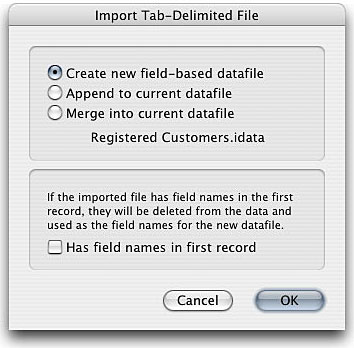Tab-delimited Basics
Tab-delimited files are plain-text files that have fields ending in the tab character and records ending in an end-of-line symbol or paragraph marker (linefeed/newline character, carriage return character, or carriage return-linefeed pair).
The tab-delimited format is widely used to move data among database applications, each of which has its own native file format, but which can export and import files in this format.
Note: If, for any reason, you feel the need to create a tab-delimited file by hand, please be aware that the number of tabs must be exactly the same for each line. Otherwise, iData will not be able to place your data into the appropriate fields, and may even crash in the attempt.
A common convention is that a tab-delimited file can be exported with a new first record that contains the name of each field in that field. iData supports this convention. However, if you have a tab-delimited file that does not contain field names in the first record, iData will use numbers for field names, and you can rename the fields later, using the Modify Fields command in the Fields sub-menu, under the Edit menu.
In addition to importing files in standard tab-delimited format, it is also possible to import a text file containing lines of text (paragraphs, ending in single returns) using this function. If you select the Create new field-based datafile option, the result will be a new datafile with a single field, and with each line of text in that field in its own record. If desired, you can add more fields later, using the Modify Fields command in the Edit menu.
To import a tab-delimited file:
1. In the Finder, make sure that the text file to be imported has a .tab, .txt or .text file name extension. This is the only way iData has of recognizing valid tab-delimited text files. (Note: However, you should not try to import files of other types by simply changing the file name extension. This will not work, and may cause iData to crash.)
2. In iData, select Tab-delimited File... from the Import menu under the File menu.
3. In the Open dialog that comes up next, navigate to your tab-delimited file, select it, and click the Open button.
4. The following dialog will appear. If there is no current datafile open that has the same number of fields as the file being imported, only the first option will be available.

5. If applicable, select one of the radio buttons. Here are what the options mean:
a. Create new field-based datafile - As you might expect, this will create a new datafile containing the imported tab-delimited data. You will be able to save the new datafile with any name you desire.
b. Append to current datafile - If this option is available, it will cause newly imported records to be added at the end of the current datafile. If you are importing a later version of the tab-delimited file that was used to create the current datafile, you will probably end up with duplicate records.
c. Merge into current datafile - If this option is available, after adding the newly imported records, iData will automatically remove all exact duplicates, so this is probably the best option for repeatedly updating a datafile for a particular tab-delimited file. Note that removing duplicates requires that the datafile be sorted by the contents of all the fields in order, so if you have rearranged the datafile for any reason, that order will be lost.
6. If the incoming tab-delimited file has field names in the first record, enable the Has field names in first record checkbox.
7. Click the OK button to start the import.
8. Once the import is complete, if you selected the first option, the result will be a new untitled datafile. In this case, we recommend that you save the new datafile right away, giving it the same name as the file from which it was imported, but retaining the required .id3 file name extension.